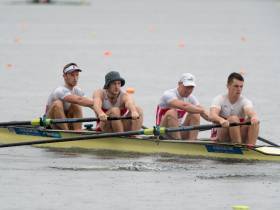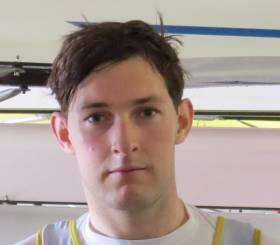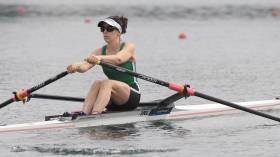Displaying items by tag: Paul O'Donovan
Murphy Adds Gold in New Zealand
#Rowing: Max Murphy added a gold medal to the silver he had won in the men’s senior pair at the New Zealand Rowing Championships today. The UCD oarsman was part of the Waikato senior eight which were clear winners, beating a crew from their own club into second. Kevin Neville and Eamon Power of NUIG were in the Wellington crew which took bronze.
In warm and calm conditions, Paul O’Donovan and Gary O’Donovan finished fourth in the Premier double sculls, an elite event won by Chris Harris and Robbie Manson.
New Zealand Rowing Championships, Lake Karapiro, Day Four (Irish interest)
Men
Eight – Senior
Final: 1 Waikato (3 M Murphy) 5:56.41; 3 Wellington (7: K Neville; 8 E Power) 6:00.28.
Pair - Senior
Final: 2 Waikato (M Murphy, T Bedford) 6:59.41.
Sculling,
Double – Premier
Final: 4 Skibbereen (P O’Donovan, G O’Donovan) 6:38.66. Senior – B Final: 1 Wairau (2 K Neville) 6:46.04.
Single – Club
B Final: 5 Wairau (E Power) 8:11.15.
Paul O'Donovan and Skibbereen Four Win Place in New Zealand Finals
#Rowing: Paul O’Donovan, in the Premier (open weight) single sculls, and the Skibbereen four both made it to A Finals at the New Zealand Rowing Championships. O’Donovan won in a repechage to join some of the top heavyweight single scullers in the world in the final. Gary O’Donovan took third in the race and will compete in the B Final.
The two brothers joined Mark O’Donovan and Shane O’Driscoll to form a four which won its repechage and will also compete in a final with top heavyweight crews.
Mark O’Donovan and Shane O’Driscoll took fifth in their repechage of the Premier Pair and missed out on the final, while Max Murphy made it through to the A Final of the men’s pair and NUIG’s Kevin Neville and Eamon Power progressed through repechages in the senior single and club single respectively.
New Zealand Rowing Championships, Lake Karapiro, Day Two (Irish interest)
Men
Four – Premier
Repechage Two (First two to A Final; rest to B Final): 1 Skibbereen (G O’Donovan, P O’Donovan, M O’Donovan, S O’Driscoll) 6:21.39.
Pair – Premier
Repechage (Top Four to Final; rest eliminated): 5 Skibbereen (S O’Driscoll, M O’Donovan) 7:11.47.
Senior
Repechage (Top Three to Final): 2 Waikato (M Murphy, T Bedford) 7:33.13.
Sculling,
Single – Premier
Repechage One (First two to Final; rest to B Final): 1 Skibbereen (P O’Donovan) 7:23.32; 3 Skibbereen (G O’Donovan) 7:55.63.
Senior
Repechage Three (First Two to Semi-Final): 2 Wairau (K Neville) 7:29.91.
Club
Repechage One (First Two to Semi-Final): 1 Wairau (E Power) 8:19.07.
Paul O'Donovan and Max Murphy Impress in New Zealand
#Rowing: Paul O’Donovan was the pick of the Irish internationals at the testing New Zealand Rowing Championships on Lake Karapiro on Tuesday. O’Donovan finished third in his heat of the Premier (openweight) single sculls – just .11 of a second behind the winner of the other heat, Mahe Drysdale, the Olympic champion. O'Donovan will get a second chance to make the final through the repechages.
The pair of Mark O’Donovan and Shane O’Driscoll took fourth in their heat, while a four with the three O’Donovans and O’Driscoll also conserved energy for Wednesday’s repechages. The double of Paul and Gary O’Donovan took part in a race for lanes and took fifth.
It was another good day for UCD’s Max Murphy, who is competing for Waikato. He was part of the club’s senior four which won their heat and progressed directly to the final. In the pair, Murphy placed third in a heat.
Kevin Neville of NUIG, competing for Wairau, qualified for the senior double semi-finals. Neville and Eamon Power, also of NUIG and rowing for Wairau, are set for repechages in the senior and club singles respectively.
New Zealand Rowing Championships, Lake Karapiro, Day One (Irish interest)
Men
Four – Premier (First to Final; rest to repechage)– Heat Two: 4 Skibbereen (S O’Driscoll, M O’Donovan, P O’Donovan, G O’Donovan) 7:05.67.
Senior (First to Final; rest to repechage) - Heat Two: 1 Waikato (3 M Murphy) 6:25.58.
Pair – Premier (First to Final; rest to repechage): Heat Two: Skibbereen (S O’Driscoll, M O’Donovan) 7:24.79.
Senior (First to Final; rest to repechage) – Heat Two: 3 Waikato (M Murphy, T Bedford) 7:11.58.
Sculling,
Double – Premier (All go to Final): 5 Skibbereen (P O’Donovan, G O’Donovan) 7:20.97.
Senior – (First Four to Semi-Finals: rest to Repechages) – Heat Three: 3 Wairau (2 K Neville) 6:50.56.
Single – Premier (First to A Final; rest to repechage) – Heat One: 4 Skibbereen (G O’Donovan) 7:45. 8. Heat Two: 3 Skibbereen (P O’Donovan) 7:20.17.
Senior (First to Final; rest to repechage) – Heat One: 3 Wairau (K Neville) 7:53.53.
Club – Heat One (First two to Semi-Final; rest to repechage) – Heat One: 3 Wairau (E Power) 8:00.75.
Sixth for Skibbereen Men While Murphy Hits Gold
#Rowing: Paul and Gary O’Donovan finished sixth in the Premier Double Sculls Final at the North Island Club Championships on Lake Karapiro in New Zealand today. Earlier, Paul O’Donovan had finished sixth of eight in the Premier Single Sculls, while Mark O’Donovan and Shane O’Driscoll had won the B Final of the Premier Pair.
Max Murphy had a very satisifactory outing. The UCD man, who has been based in New Zealand, took the senior eight and four with Waikato.
North Island Rowing Championships, Lake Karapiro, New Zealand (Irish interest)
Men
Senior Eight – A Final: 1 Waikato (3: M Murphy) 6:19.55.
Senior Four – A Final: 1 Waikato (3 M Murphy) 6:15.01.
Premier Pair – B Final: 1 Skibbereen (M O’Donovan, S O’Driscoll) 6:43.34.
Senior Pair – A Final: 4 Waikato (M Murphy, T Bedford) 6:51.51.
Premier Double Sculls – Final: 6 Skibbereen (P O’Donovan, G O’Donovan) 6:50.76.
Premier Single – A Final: 1 R Manson 6:39.58; 6 Skibbereen (P O’Donovan) 6:54.63. B Final: 3 Skibbereen (G O’Donovan) 6:57.21.
North Island Final A Heavyweight Test for Paul O'Donovan
#Rowing: Paul O’Donovan finished sixth of the eight competitors who reached the A Final of the Premier Single Sculls at the North Island Club Rowing Championships in New Zealand. Robbie Manson, the top heavyweight single sculler won. Gary O’Donovan took third place in the B Final.
Mark O’Donovan and Shane O’Driscoll won their B Final of the Premier Pair, taking ninth overall. Max Murphy, the former UCD captain, was part of the Waikato senior pair which finished fourth in their final.
North Island Rowing Championships, Lake Karapiro, New Zealand (Irish interest)
Men
Premier Pair – B Final: 1 Skibbereen (M O’Donovan, S O’Driscoll) 6:43.34.
Senior Pair – Final: 4 Waikato (M Murphy, T Bedford) 6:51.51.
Premier Single – A Final: 1 R Manson 6:39.58; 6 Skibbereen (P O’Donovan) 6:54.63. B Final: 3 Skibbereen (G O’Donovan) 6:57.21.
Paul O'Donovan Makes Heavyweight Final in New Zealand
#Rowing: Paul O’Donovan qualified for the Final of the Premier Single Sculls, a heavyweight event, at the North Island Championships in New Zealand today. The Skibbereen man finished second in his repechage, behind New Zealand international Matthew Dunham and ahead of the former world and Olympic champion Mahe Drysdale. All three qualified. Gary O’Donovan finished fourth, one place from qualification.
North Island Rowing Championships, Lake Karapiro, New Zealand (Irish interest)
Men
Senior Four – Heat One: 1 Waikato (W Guest, T Bedford, M Murphy, J Ingham) 6:18.85.
Premier Pair – Heat One (First to Final; rest to repechage): 4 Skibbereen (S O’Driscoll, M O’Donovan) 6:44.25. Repechage One (First Three to Final; rest eliminated): 4 Skibbereen (O’Driscoll, M O’Donovan) 6:41.12.
Senior Pair – Heat One (First to Final): 1 Waikato (M Murphy, T Bedford) 6:50.16.
Premier Single Sculls – Heat One (Winner to Final; rest to Repechage): 6 Skibbereen (P O’Donovan) 7:25.42. Heat Two: 6 Skibbereen (G O’Donovan) 7:28.38. Repechage One (First Three to A Final): 1 M Dunham 7:05.97, 2 Skibbereen (P O’Donovan) 7:07.45, 3 M Drysdale 7:12.51; 4 Skibbereen (G O’Donovan) 7:15.84.
First Outing for O'Driscoll and O'Donovan as Heavyweights in New Zealand
#Rowing: Mark O’Donovan and Shane O’Driscoll competed as a heavyweight pair at the North Island Championships in New Zealand today. The world champions in the lightweight pair, who have switched to heavyweight in the hope of competing at the 2020 Olympic Games in Tokyo, finished fourth in their heat.
Paul O’Donovan and Gary O’Donovan both finished sixth in their heats of the single sculls. Both also competed as heavyweights.
All three boats move into repechages on Sunday.
Afloat Honours Paul O'Donovan
#Rowing: Paul O’Donovan is the Afloat Rower of the Month for November. The Skibbereen man beat all comers to show himself the top single sculler at the Ireland Trial. He teamed up with his Olympic crewmate and brother, Gary, in a fast double on the Sunday.
Paul O’Donovan is the world champion in the lightweight single sculls. He was a UCD Alumni Award winner in November, the youngest ever. He is 23.
Rower of the Month awards: The judging panel is made up of Liam Gorman, rowing correspondent of The Irish Times, and David O'Brien, editor of Afloat magazine. Monthly awards for achievements during the year will appear on afloat.ie. Keep a monthly eye on progress and watch our 2017 champions list grow.
Muckross Head of the River Attracts Impressive Entry
#Rowing: Top internationals, including world champion Paul O’Donovan, Denise Walsh and Monika Dukarska, are amongst the big entry of over 400 crews from 26 clubs entered for the Muckross Head of the River on Saturday at the National Rowing Centre. The Ireland women’s pair which competed at the World Championships, Aileen Crowley and Aifric Keogh, are also entered. They are set to take on Emily Hegarty and Tara Hanlon, the crew which came closest to matching them at the recent Ireland Trial.
O'Donovans On Song at Ireland Rowing Trial
#Rowing: Paul O’Donovan and Gary O’Donovan, in a lightweight double scull, tied for the best time with a men’s heavyweight four on the second day of the Ireland trial over six kilometres today. The fastest women’s crew was the four of Tara Hanlon, Emily Hegarty, Aileen Crowley and Aifric Keogh. The double of Claire Lambe and Monika Dukarska were next fastest.
Ireland Trial, National Rowing Centre, Sunday (6 km; selected results):
Men
Four: Shandon/St Michael’s (Murphy, Prendergast, McKeon, Garvey) 21 min 22 sec
Doubles: G O’Donovan, P O’Donovan (lwt) 21:22; R Byrne, S McKeown (hwt) 21:36.
Women
Four: Old Collegians, Skibbereen, UCC (T Hanlon, E Hegarty, A Crowley, A Keogh) 22:54.
Double: M Dukarska, C Lambe (hwt) 23:12; D Walsh, A Casey (lwt) 23:35




































































